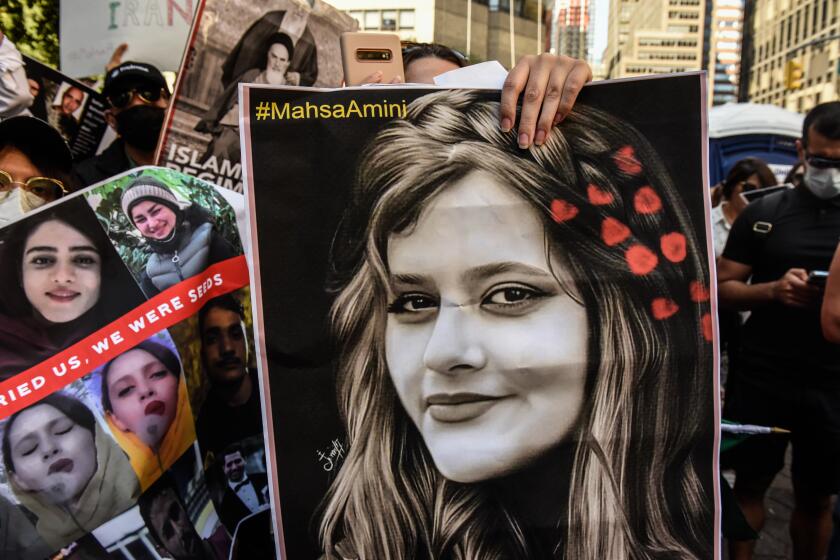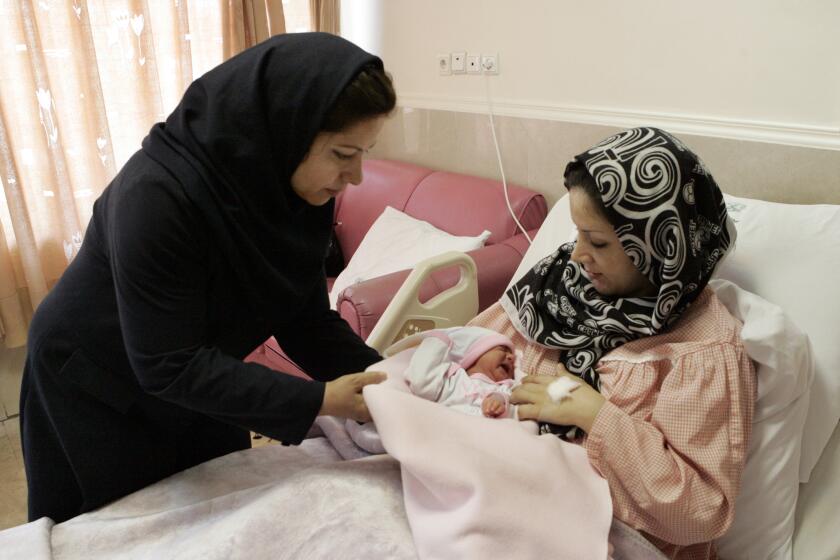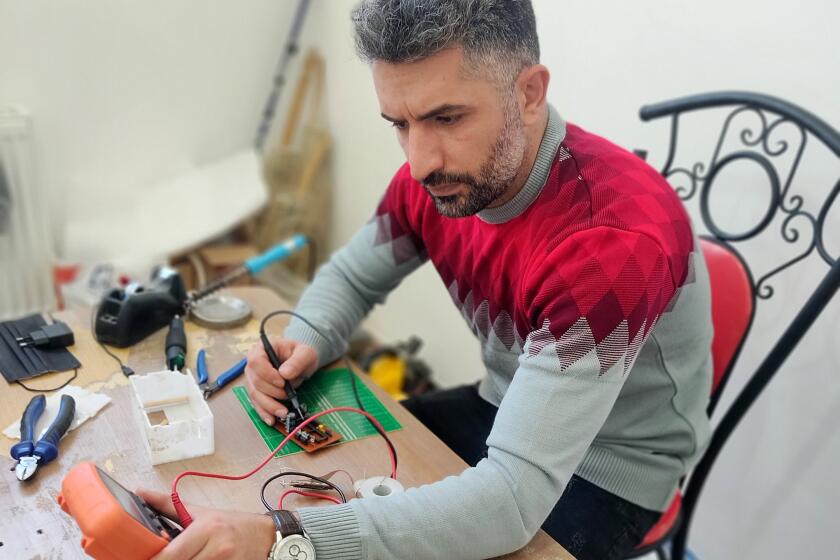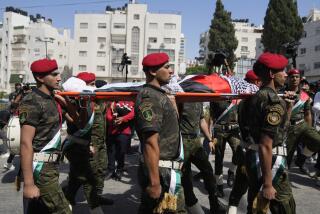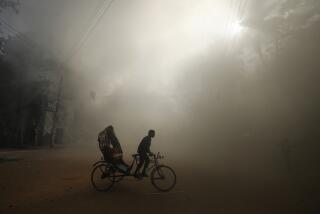Mass protests roil Iran over a young woman’s death, but can they succeed?
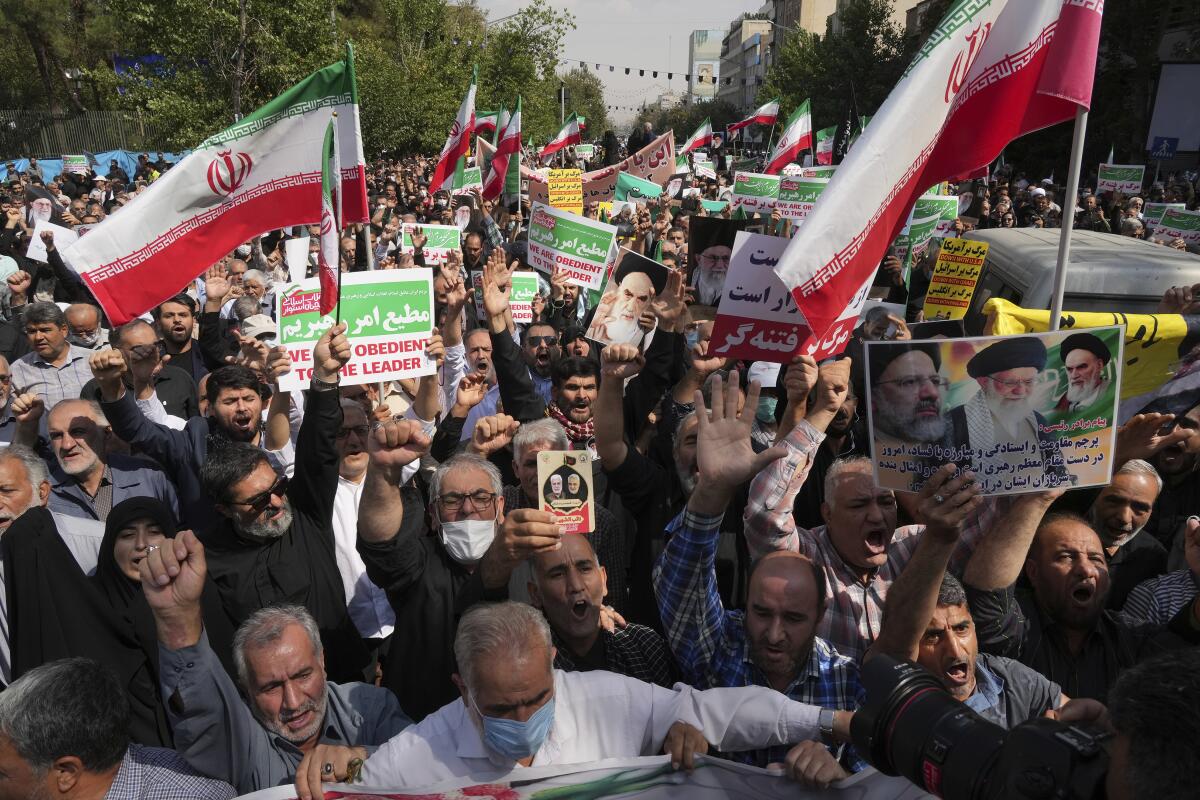
- Share via
TEHRAN — The death last week of 22-year-old Mahsa Amini, after Iran’s notorious morality police arrested her because they thought she was not dressed conservatively enough, sparked one of the most intense waves of popular anger the country has seen in years, as well as a deluge of condemnation from abroad.
For a week now, protesters, most of them young women and men, have taken to the streets in dozens of Iranian cities. The scale of the demonstrations has astonished authorities, who have responded with guns, beatings and telecommunications shutdowns in a fruitless attempt to quell the unrest. State television put the death toll at 17, including two security officers. One rights group says the total number of people killed could be at least twice that.
What will the protests mean for the country’s hard-line government? And how do they compare with previous bouts of unrest?
Here’s a look at a volatile situation that some fear will produce more bloodshed in the coming days.
Why did this death trigger such anger?
Amini, a Kurdish woman from the northwestern city of Saqez, was visiting Tehran on Sept. 13 when she was detained by the so-called morality police (the Gasht-e Ershad, or guidance patrols), who said she was wearing tight trousers and didn’t have her headscarf on properly, in violation of a law that mandates women wear a hijab and loose-fitting clothes so as to disguise their figures in public.
Activists said she was beaten with a baton on her head and suffered other injuries that were serious enough to put her in a coma. Three days later she was dead. Authorities deny beating Amini and insisted in a statement that the cause of death was sudden heart failure, possibly from preexisting conditions.
Protests spread to L.A. on Wednesday over Mahsa Amini’s death in Iranian morality police custody after she was accused of improperly covering her hair.
“They are lying,” Amjad Amini, the young woman’s father, told BBC Persian on Thursday. “She has not been to any hospital at all in the past 22 years, other than for a few cold-related sicknesses.”
He added that his son had witnessed his sister being beaten in the van and police station and was himself roughed up by officers.
Many Iranian women have long called for the abolition of the so-called hijab laws, but Amini’s death struck a chord in ways that few events have — perhaps because she was young, modest and an out-of-towner visiting the capital. Whatever the reason, they responded to news of her death by staging demonstrations, cutting off their hair, burning their hijabs and shouting, “Death to the dictator!” in a direct broadside against Iran’s Supreme Leader Ayatollah Ali Khamenei.
Are the protests only about Amini’s death?
The demonstrations have grown to become a catchall for other long-percolating grievances, including those left over from the mass protests of 2019 over Iran’s sanctions-crippled, collapsing economy. Those demonstrations led to the bloodiest crackdown since the Islamic Revolution of 1979, with hundreds of people — some reports say as many as 1,500 — dead.
The lack of civil liberties, the dismal economic conditions and the fitful negotiations with the West to restore a moribund nuclear deal and get sanctions reduced have all fed into a wider sense of anger.
Protests continued in Iran and elsewhere after a 22-year-old Iranian woman who was accused of not wearing her hijab properly died in police custody.
Iran’s 2021 presidential election, which brought hard-liner Ebrahim Raisi to power as an uncontested candidate, further marginalized large swaths of society. Raisi rolled back many of the reforms of the last two decades and boosted the morality police.
In June, the morality police arrested a young woman named Sepideh Rashnou, who had debated the necessity of the compulsory hijab with a pro-government woman on a bus in Tehran. A week later, state TV showed Rashnou with bruises on her face making a confession that she had acted inappropriately. The confession went viral.
What’s the current situation?
The last six days have seen anti-government protests in about 80 cities and towns, with some presenting an open challenge to the government with slogans targeting Khamenei. Reports have emerged of demonstrators torching waste containers, blocking access to streets and burning police vehicles as riot police respond with tear gas, water cannons and beatings.
Video clips of protesters apparently being gunned down in different cities have gone viral, while a hashtag with Amini’s name has been retweeted some 30 million times, pushing the government to block or curtail internet services, including messaging applications such as WhatsApp.
The death toll remains unclear, but human rights groups say that at least 36 people have been killed. Authorities have said they will release official figures later. On Thursday night, security forces launched a massive dragnet targeting social activists and journalists, arresting hundreds.
Hengaw, a Norway-based Kurdish rights group, said that, by Wednesday, 15 people had been killed, along with 733 injured and 600 others arrested.
Alarmed by the nation’s low birth rate, the Iranian government is encouraging childbearing and imposing restrictions on abortion and contraception.
On Friday, the government staged a counterdemonstration, with thousands gathering in Tehran and echoing the state’s line that the demonstrations were part of a foreign-backed conspiracy against Iran’s leadership. Netblocks, an internet monitoring group, reported Friday that internet services were disrupted for a third time in the last week, with some of the most severe restrictions since the 2019 crackdown.
Amini’s death has also inspired protests abroad, including in the U.S., Canada, Germany, Greece, the Netherlands, Italy, Lebanon, Spain and Turkey.
How does this compare to previous mass protests, and can these succeed where those failed?
It’s clear that the protests constitute the most serious challenge to the government since 2019. Yet where those riots were caused by economic concerns — the proximate cause was a hike in gas prices — the demonstrations now are more focused on social aspects, with even religious conservatives raising concerns about the behavior of the morality police.
Another important difference is that protests have seen a more aggressive tack from demonstrators more willing to fight back against security forces. The scale of the violence, at least according to clips and videos, appears to be greater.
The controversy has also forced the government to weigh in. Speaking at a news conference on the sidelines of the United Nations General Assembly, Raisi said he had assured the Amini family that the incident would be investigated, even as he accused the West of “double standards” when it comes to human rights.
“Our utmost preoccupation is the safeguarding of the rights of every citizen,” he said. “If her death was due to negligence, it will definitely be investigated, and I promise to follow up on the issue regardless of whether the international forums take a stand or not.”
Mohsen Chavoshi, one of Iran’s most famous singers, has helped rescue more than 50 people from the gallows in a country where justice can be harsh.
Other officials have resorted to a standard tactic of demonizing protesters. On Wednesday, Tehran Gov. Mohsen Mansouri tweeted that many of those demonstrating “have a history of attending gatherings and sometimes riots,” adding that just under half had “significant records and files in various police, security and judicial institutions.”
He also claimed a day earlier that core organizers were “trained” to create disturbances.
Despite that rhetoric, the protests have elicited support from artists, athletes, singers and celebrities.
“Don’t be afraid of strong women. Maybe the day will come when they are your only army,” tweeted Ali Karimi, an Iranian soccer star. Mohammad Fazeli, a prominent sociologist, said: “The responsibility to end the violence lies with the establishment which controls media, decision-making, and everything else.”
Times staff writer Bulos reported from Amman, Jordan. Special correspondent Omid Khazani in Tehran contributed to this report.
- Share via
Watch L.A. Times Today at 7 p.m. on Spectrum News 1 on Channel 1 or live stream on the Spectrum News App. Palos Verdes Peninsula and Orange County viewers can watch on Cox Systems on channel 99.
More to Read
Sign up for Essential California
The most important California stories and recommendations in your inbox every morning.
You may occasionally receive promotional content from the Los Angeles Times.

